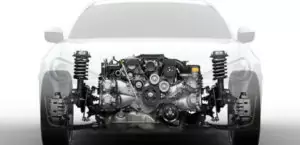The 2.2-liter inline diesel engine Mercedes OM 646 was produced from 2002 to 2010 and was installed on the C-Class, CLK-Class and E-Class models, as well as Vito and Sprinter minibuses. There was a version of such a transverse diesel engine OM 644 for the Chrysler PT Cruiser.
The diesel R4-family includes: OM616, OM601, OM604, OM611, OM640, OM646, OM651, OM654, OM668.
In 2002, as a result of the modernization of the OM611 4-cylinder diesel engine, a new unit appeared. The design of the motor as a whole has not changed so much: it has the same cast-iron cylinder block, a two-row timing chain and an aluminum 16-valve cylinder head equipped with hydraulic compensators. However, a more modern Bosch common rail fuel system with a CP3 pump and simple seven-hole solenoid injectors with an injection pressure of 1600 bar appeared. It is worth noting the intake manifold with electronically controlled swirl flaps EKAS, as well as the advanced turbine with variable geometry and electric drive Garrett GTA1852VK. Modifications for passenger cars were equipped with a pair of balance shafts of the Lanchester type.
The Mercedes OM646 engine was equipped with a second generation Common-Rail fuel system with a maximum injection pressure of 1600 bar, with new 7-hole injectors. The smaller diameter of the nozzles allowed for better fuel atomization. The fuel system provided 2 pilot injections. Injection of fuel before direct injection, which causes the combustion of the fuel charge, allows the temperature in the combustion chamber to be reduced due to the evaporation of the fuel, correspondingly lowering the average operating cycle temperatures and pressures. Thus, NOx emissions are reduced, the diesel engine runs smoothly, and noise and vibration are reduced. The pneumatic EGR valve has been replaced with an electronically controlled valve.
In 2006, Mercedes-Benz upgraded the OM646 diesel. The updated OM646 EVO has 90 parts replaced. The compression ratio of the diesel engine was lowered from 18.0 to 17.5. Higher pistons and shorter connecting rods were used. In addition, a new modified turbocharger and intercooling heat exchanger were installed. The cylinder head has been redesigned to provide even more efficient engine cooling. Ceramic glow plugs were used to improve engine starting. There was also a bi-turbo modification for the Sprinter with a pair of turbochargers from BorgWarner.
Compliance with environmental standards Euro-5 is the first characteristic feature of this engine. In order to improve environmental performance, the designers have revised the algorithms for the fuel supply of the engine control unit. Other changes were also made:
- the EGR valve was replaced, installed a new DPF and catalyst;
- the size of the intercooler heat exchanger was increased;
- all pressure and temperature regulators have been updated.
Specifications
| Production years | 2002-2010 |
| Displacement, cc | 2148 |
| Fuel system | Common Rail |
| Power output, hp | 88 – 122 (DE 22 LA red) 129 – 150 (DE 22 LA) 136 (DE 22 LA EVO red) 170 (DE 22 LA EVO) |
| Torque output, Nm | 220 – 290 (DE 22 LA red) 305 – 340 (DE 22 LA) 270 – 340 (DE 22 LA EVO red) 400 (DE 22 LA EVO) |
| Cylinder block | cast iron R4 |
| Block head | aluminum 16v |
| Cylinder bore, mm | 88 |
| Piston stroke, mm | 88.3 |
| Compression ratio | 18.0 (DE 22 LA red, DE 22 LA) 17.5 (DE 22 LA EVO red, DE 22 LA EVO) |
| Hydraulic lifters | yes |
| Timing drive | double row chain |
| Turbocharging | Garrett GTA1852VK |
| Recommended engine oil | 5W-40, MB 229.5 / 229.51 |
| Engine oil capacity, liter | 6.5 / 8.5 / 9.5 (Passenger cars / Vito / Sprinter) |
| Fuel type | diesel |
| Euro standards | EURO 3 (DE 22 LA red, DE 22 LA) EURO 4 (DE 22 LA EVO red, DE 22 LA EVO) |
| Fuel consumption, L/100 km (for Mercedes E 220 CDI 2005) — city — highway — combined |
8.8 5.0 6.3 |
| Engine lifespan, km | ~400 000 |
| Weight, kg | 204 |
The engine was installed on:
- Mercedes C-Class W203 in 2003 – 2007; C-Class W204 in 2007 – 2009;
- Mercedes CLC-Class C203 in 2008 – 2010;
- Mercedes CLK-Class C209 in 2005 – 2009;
- Mercedes E-Class W211 in 2002 – 2009;
- Mercedes Sprinter W906 in 2006 – 2009; Sprinter Classic since 2013;
- Mercedes V-Class W639 in 2003 – 2010.
Disadvantages of the OM646 engine
- The motor is equipped with a reliable Bosch fuel system with electromagnetic injectors, but leaks at the injection pump seals or wear of the metering valve are common. And also, like its predecessor, refractory washers under the nozzles often burn out.
- A lot of trouble here is delivered by the plastic swirl flaps of the intake manifold: they quickly break and fall off, and air is sucked in through the holes of their axles.
- The most serious problem is the cranking of the liners on a run of 200 – 300 thousand km. The main reason is considered to be poor maintenance, so renew the lubricant more often.
- Like many others, these diesels are often plagued by oil leaks or air leaks. Single turbo versions are reliable, but bi-turbo modifications can be a hassle.






